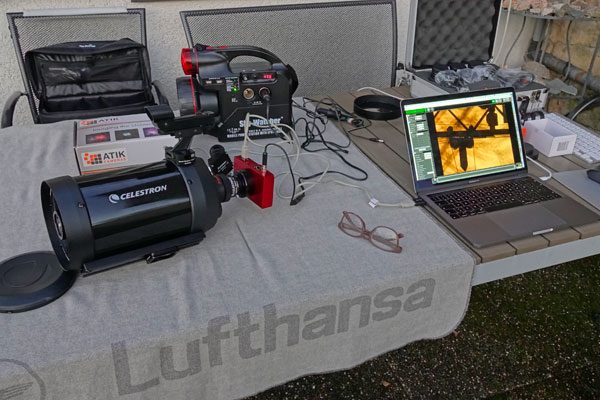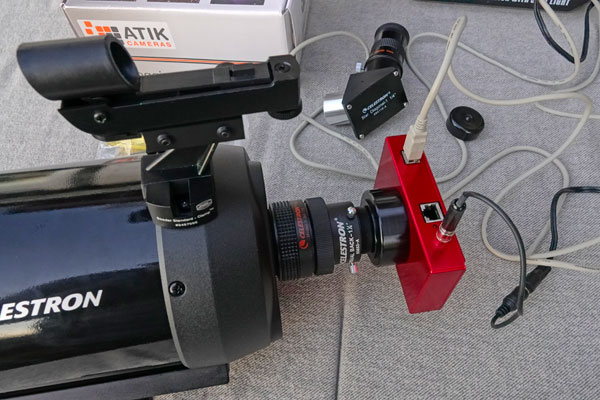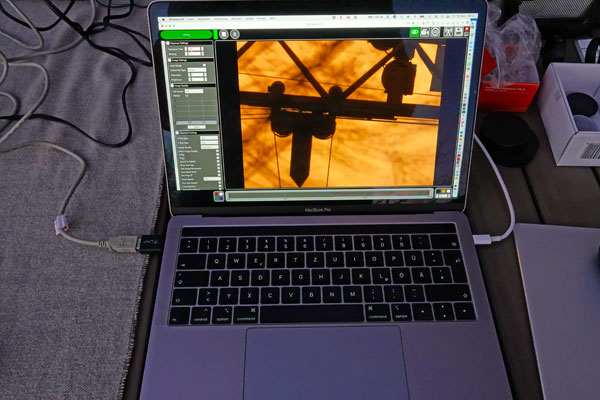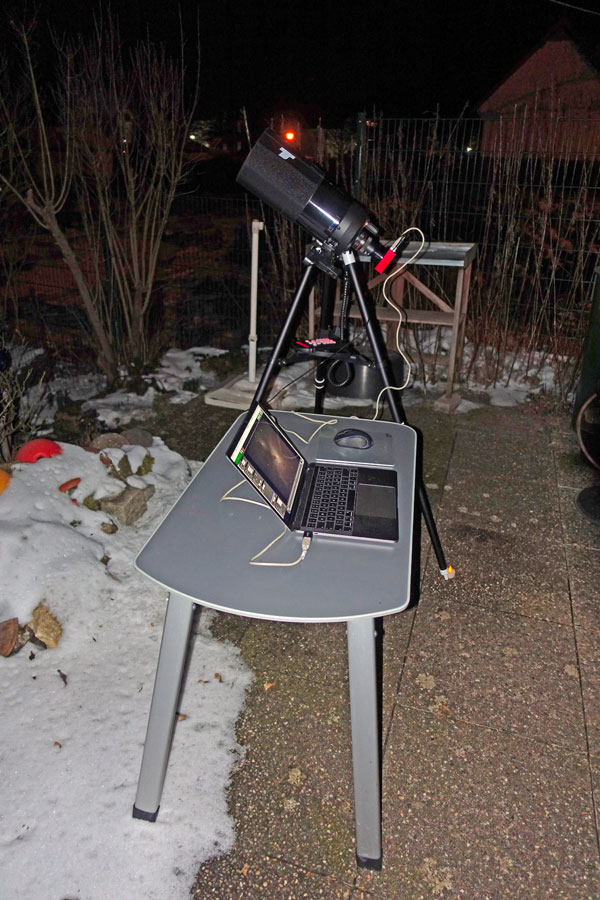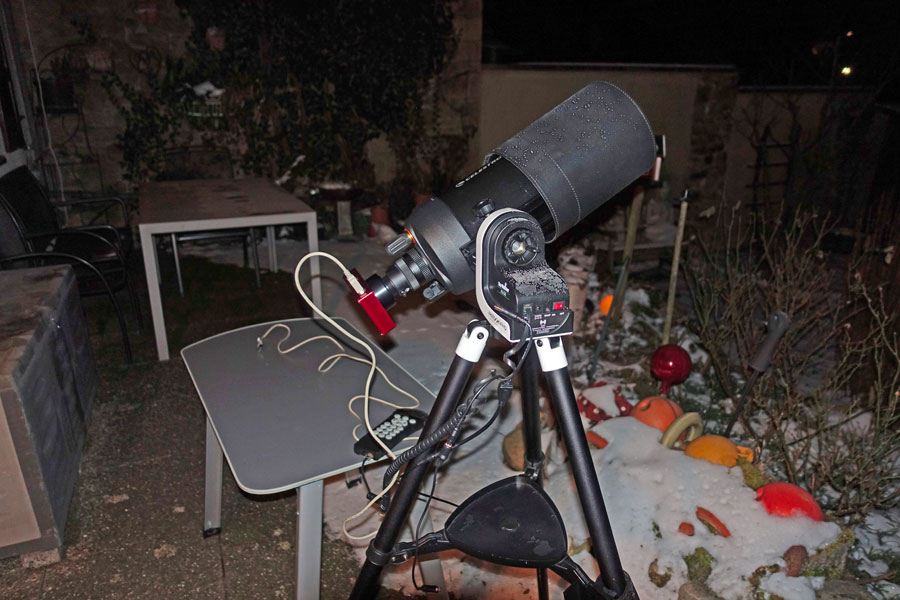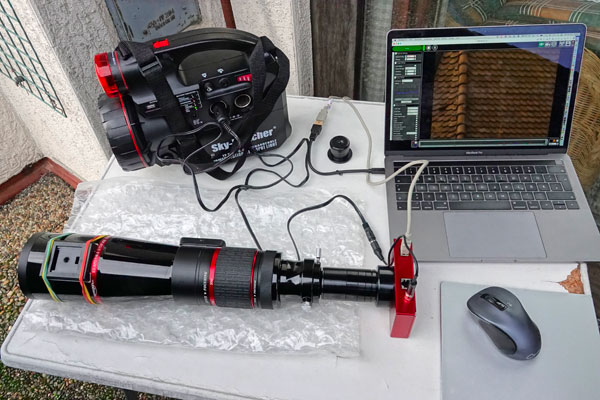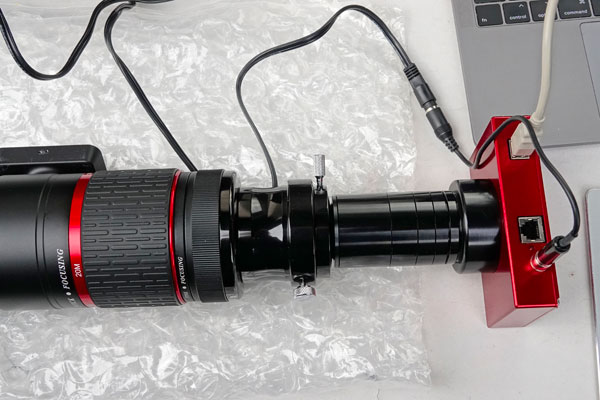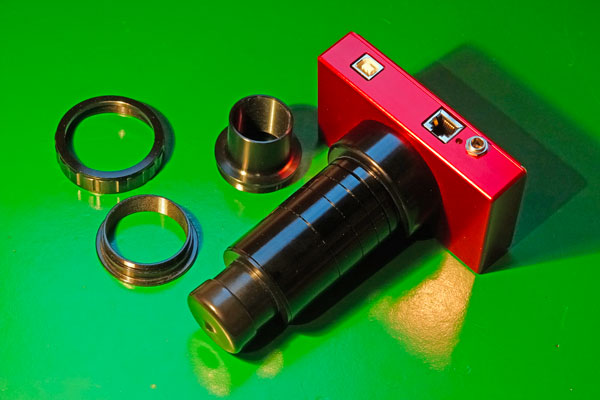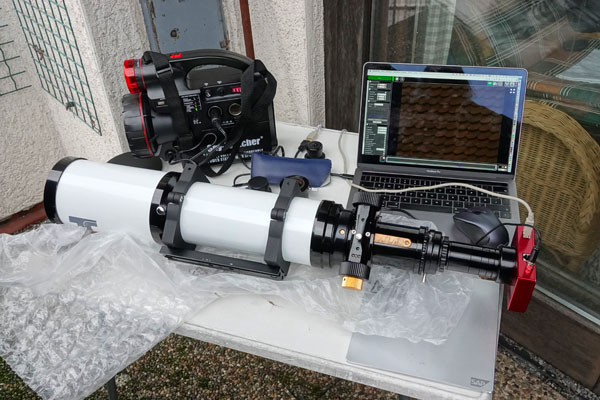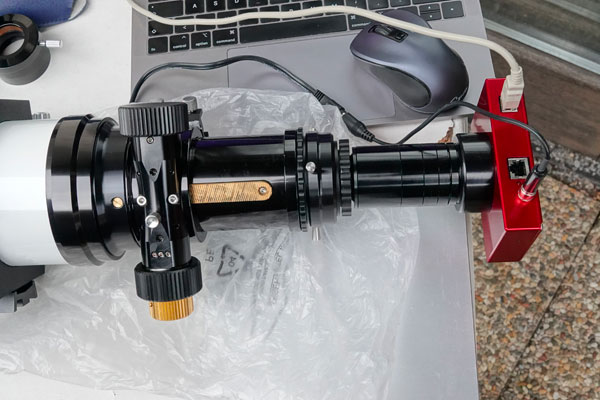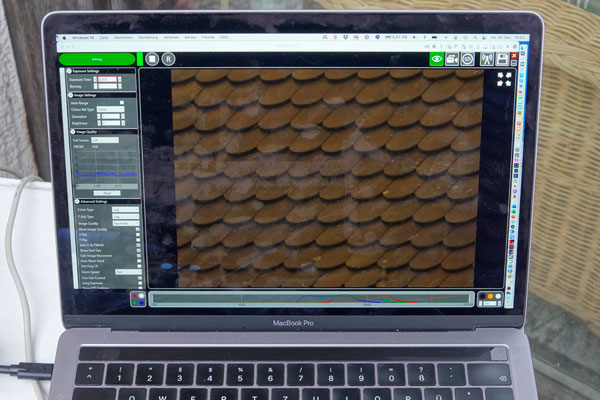Deep Sky Observations with Atik Infinity 2021
Conditions | Observation Overview | Remarks | References
Archive
At the beginning of 2021, I used the Atik Infinity camera again a little on my Celestron C5, TS-Optics TLAPO 1027, and Omegon PS 72/432. In February, I used the Celestron f/6.3 reducer/corrector together with my C5. Prior to these observations, I did "dry runs" to see with which equipment I would get into focus with the Atik Infinity. See page Atik Infinity Colour Camera - Further Experiences for details on the dry runs (relevant are the the dry runs from December 2020) and observations. I also present photos there.
Furthermore, I present the photos, except in galleries, only directly on the detail pages for the sky objects. There are no more pages for single "observation days" in order to keep the effort a bit lower.
Note: I sold my Atik Infinity at the beginning of January 2023.
Conditions
Sky Region and Objects
I looked into different sky regions, so a description does not make much sense here.
Overview Map
Since the observations will be separated through a long period of time, a sky map does not make much sense.
Observation Time
The observations started every day when it was sufficiently dark.
Observation Location
All observations were conducted in Mühlhausen/Kraichgau (Germany):
- Coordinates: 49° 15′ N , 8° 43′ E
- Coordinates (dec.): 49,25° N, 8,72° E
Equipment Used
Camera, Laptop, Focal Reducer, GoTo Mount, Power Supply
Of course, the Atik Infinity camera is needed for taking photos. To operate the camera, a laptop on which the control application runs is also required. Depending on the telescope tube used, focal length reducers must also be used. This is indicated for the respective observations. And, of course, you need a GoTo mount and a power supply, typically a power tank. If you control the mount via app, you also need a smartphone.
Telescope Tubes
Celestron C5
I acquired this Schmidt-Cassegrain tube (1250 mm, f/10) at the end of 2020. On this tube, the camera gets into focus when using focal length reducers, but also completely without reducers. Celestron's f/6.3 reducer/corrector was specifically designed for this tube (and similar ones). Below, there is a test setup with the C5:
|
C5 with 1.25" visual back and f/6.3 reducer/corrector |
C5 with 1.25" visual back and f/6.3 reducer/corrector |
Result for C5R |
In addition, the telescope tube has always to be mounted on a GoTo mount, because sky objects need to be tracked when being observed and photographed with a camera. In February 2021, this was the AZ-GTi mount. And last but not least, you need a 12 V power supply for the camera and GoTo mount (and possibly one for the laptop).
On February 13, 2021, my C5 equipment got icy in the end:
|
C5 with 1,25" visual back and f/6.3 reducer/corrector on AZ-GTi mount |
PS 72/432
I bought the Omegon PS 73/432 ED refractor (432 mm, f/6) in September 2018, but had never used the Atik Infinity camera at it. This happened in March 2021 for the first time. To be able to get into focus, I used the newly acquired T2 extension sleeves (Explore Scientific) for the first time in practice (see the photos below). I do not have photos of the setup with the AZ-GTi mount and the computer, but the setup resembles the one with the C5.
|
PS 72/432 with T2 extension sleeves, overview |
PS 72/432 with T2 extension sleeves |
Atik Infinity with T2 extension sleeves |
TLAPO 1027
I purchased the TS-Optics TLAPO1027 refractor in July 2020 and have only used it infrequently since then. In March 2021, I tried the Atik Infinity on this tube for the first time. To be able to get into focus, I used the newly acquired T2 extension sleeves (Explore Scientific) (see photos). I do not have photos of the setup with the Star Discovery mount and computer, but the setup is similar to the one with the C5.
|
TLAPO1027 with T2 extension sleeves, overview |
TLAPO1027 with T2 extension sleeves |
Result |
General Conditions
In general, the sky above Mühlhausen/Kraichgau is "light-polluted" and does not invite you to search for deep sky objects. Cameras will find the objects even in worse conditions, but really good results are obtained only under dark skies.
Observation Overview
Observation Details
| Date | Observed Objects | Further Observations and Remarks | Devices Used | Reducers Used | General Remarks |
| Feb 13 MH |
OC: M 35, M 45 GN: M 42/43, M 78 |
f/6.3 reducer/corrector: M 35, M 42/43 (Orion Nebula), M 45 (Pleiades), M 78, M 42/43 once more | C5 on AZ-GTi with Atik Infinity | f/6.3 reducer/corrector | 2-star-alignment via handbox The Infinity software got often stuck and had to be restarted. All in all, somewhat disappointing results; in the end, the dew cap and the mount were a little icy... |
| Mar 19 MH |
GN: M 42/43, M 78, NGC 2024 | M 42/43, NGC 2024 (Flame Nebula), M 78 | PS 72/432 on AZ-GTi with Atik Infinity | --- | 1-star alignment via SynScan app on iPhone. All in all, somewhat disappointing results; in the end, some dew on the equipment... . The stars looked somewhat blown up. Focusing wa difficult (hysteresis). |
| Mar 23 MH |
GN: M 42/43, M 78 | M 42/43, M 78 (faint)
Not found: NGC 2024, NGC 1977 (did not try Horse Head Nebula B 33) |
TLAPO1027 on Star Discovery with Atik Infinity | --- | 1-star alignment via SynScan app on iPhone. Overall rather disappointing results; tube had a bit dew at the end of the session, front lens probably not. Strange dark spots in the background, especially for M 78; was not able to detect any dirt on the sensor the next morning except for some dust on the glass pane above the sensor... |
| Mar 24 MH |
OC: M 35 GN: M 42/43, M 78, NGC 1977, NGC 2024 |
M 42/43, NGC 1977 (Running Man Nebula), NGC 2024 (Flame Nebula), M 35, M 78 | TLAPO1027 on Star Discovery with Atik Infinity | --- | 1-star alignment via SynScan app on iPhone. I tried a few things, everything worked right away, but the results were rather disappointing, except for those for M 42. Then also clouds appeared. Focusing was easier with the new refractor, especially since I am now using the FWHM values as a guide. I experimented with different exposure times (5, 10, 15 and 30 seconds). At 30 seconds, nothing worked at all. 15 seconds seems to be the optimum for many object, 5-10 seconds will probably provide better sharpness... |
| Mar 25 MH |
OC: M 45 GN: M 42/43, NGC 1977, NGC 2024 DN: B 33 |
M 42/43, M 45, NGC 1977 (Running Man Nebula), NGC 2024 (Flame Nebula without and with Horse Head Nebula B 33), M 42/43 once more at the end | PS 72/432 on AZ-GTi with Atik Infinity | --- | 1-star alignment via SynScan app on iPhone. The stars were very blown up, despite many focusing attempts; this could also be due to the refractor (dew on the front lens?)... Overall extremely noisy results, probably because of the bright moon. All photos taken with 15 seconds exposure time. |
| Apr 3 MH |
GN: M 42/43, NGC 2024 DN: B 33 |
M 42/43, NGC 2024 (Flame Nebula with Horse Head Nebula B 33, B 33 probably missed) | PS 72/432 on AZ-GTi-EQ with Atik Infinity | --- | 1-star alignment via SynScan app on iPhone. The stars were again very blown up. Photos taken with 15, 30, and 60 seconds exposure time. |
| Apr 4 MH |
GN: M 42/43 G: M 105, NGC 3384, NGC 3389 |
M 42/43, M 105 with NGC 3384 (elliptical) and NGC 3389 (spiral) | C5 on AZ-GTi-EQ with Atik Infinity | f/6,3 reducer/corrector | 1-star alignment using Rigel and 2-star-alignment using Rigel/Castor
via SynScan app on iPhone. The stars were not quite as blown up as with the PS72. Photos taken with 15 and 30 seconds exposure time. |
Bold: First observation during this observation period; G = galaxy, OC = open star cluster, GC = globular star cluster, P = star pattern, DN = dark nebula
Overview of the Observed Sky Objects (Mostly Objects Found)
|
DSO Details
|
Name | Constellation | Type | Tube | Remarks |
| B 33 | Horse Head Nebula | Orion | DN | PS72 | Observed together with NGC 2024; only to be guessed... |
| M 35 | Gemini | OS | C5R, TLAPO1027 | Not as nice as expected | |
| M 42/43 | Orion Nebula | Orion | GN | C5R, PS72, TLAPO1027 | In different sizes, better than in the eVscope, particularly the Trapezium |
| M 45 | Pleiades | Taurus | OS | C5R, PS72 | Too extended for the C5R |
| M 78 | Orion | GN | C5R, PS72, TLAPO1027 | Basically faint and noisy with all tubes... | |
| M 105 | Leo | G | C5R | Bright elliptical galaxy; can be seen together with the galaxies NGC 3384 (elliptical) and the smaller NGC 3389 (spiral) in the same field of view. | |
| NGC 1977 | Running Man Nebula | GN | PS72, TLAPO1027 | Recognizable, particularly with the TLAPO1027 | |
| NGC 2024 | Flame Nebula | Orion | GN | PS72, TLAPO1027 | Faint |
| NGC 3384 | Leo | G | C5R | The galaxies NGC 3384 (elliptical) and the smaller NGC 3389 (spiral) can be seen together with the galaxy M 105 in the same field of view. NGC 3384 is to the left of M 105. | |
| NGC 3389 | Leo | G | C5R | The galaxies NGC 3384 (elliptical) and the smaller NGC 3389 (spiral) can be seen together with the galaxy M 105 in the same field of view. NGC 3389 is below NGC 3384. |
G = galaxy, OC = open star cluster, GC = globular star cluster, DS = double star, SP = star pattern, DN = dark nebula
Remarks
Preparation
When searching for deep sky objects, a good preparation is obligatory - you read this, and I can confirm it. "Good preparation" means, on the one hand, that you compile a list of objects that you want to observe, including notes on where and how to find them.
On the other hand, even when doing "quick astro photography" with the Atik Infinity camera (a variety of "video astronomy") more technology has to be prepared than for purely visual observation, especially if you just put a small Dobson or Maksutov telescope on the terrace table for this... Above, I describe, what equipment I use and need for taking photos with the Atik Infinity camera.
References
Books
- Michael Feiler & Philip Novak (2023). Deep Sky Reiseatlas (5. Auflage), Oculum Verlag (ISBN 978-3-949370-04-5)
www.oculum-verlag.de/detailview?no=608 - Ronald Stoyan (2021). Deep Sky Reiseführer (6. Auflage), Oculum Verlag (ISBN 978-3-938469-72-9)
www.oculum-verlag.de/detailview?no=603 - Erich Karkoschka (2022). Atlas für Himmelsbeobachter, Kosmos Verlag (EAN: 9783440173602)
www.kosmos.de/de/atlas-fur-himmelsbeobachter_1074889_9783440173602
On this Website
- Overview of Observations
- Celestron C5 OTA Information (5" Schmidt-Cassegrain)
- Omegon Photography Scope 72/432 ED OTA Information (2.8" Refractor)
- TS-Optics Photoline 102/715 (4" Refractor)
- Sky-Watcher Star Discovery AZ GoTo Mount Information
- Sky-Watcher AZ-GTi AZ GoTo Mount Information
- Wedge for Sky-Watcher AZ-GTi AZ GoTo Mount Information
- Sky-Watcher SynScan WLAN Information
- Atik Infinity Colour Camera - Information
| 28.04.2024 |
